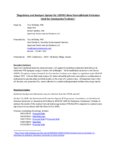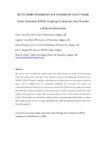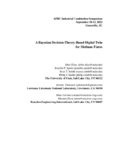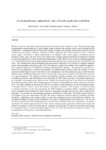TO
| Title | Date | Subject | Description | ||
|---|---|---|---|---|---|
| 1 |
 |
"Regulatory and analyzer update for USEPA's new formaldehyde emissions limit for combustion turbines" | 2019 | Spectrum's technical team has demonstrated a <27 ppbvd Formaldehyde detection limit (DL) on its extractive FTIR equipped using a 5-meter cell pathlength. This formaldehyde detection is well below USEPA's 91 ppbvd emission threshold for Combustion Turbines now subject to regulation under NESHAP Subpa... | |
| 2 |
 |
1984 baseline projections executive summary | 1984-09 | ||
| 3 |
 |
1986 baseline projections | 1986-06 | ||
| 4 |
 |
1987 baseline projections | 1987-04 | ||
| 5 |
 |
2012 Faculty Report | 2012 | 2012 Faculty Report; 2012 General Catalog; University of Utah catalogue; (Catalog) | The faculty report is generated by USpace through Academic Computing Services. It is provided as a companion to the Web archived version of the University of Utah catalogue;, found at http://content.lib.utah.edu/cdm/ref/collection/ir-eua/id/3085 |
| 6 |
 |
2013 Faculty Report; 2013 General Catalog | 2013 | University of Utah catalogue; (Catalog) | The faculty report is generated by USpace through Academic Computing Services. It is provided as a companion to the Web archived version of the University of Utah catalogue;, found at http://content.lib.utah.edu/cdm/ref/collection/ir-eua/id/3113 |
| 7 |
 |
3D CFD model development and validation for once-through steam generator (OTSG): coupling combustion, heat transfer | The current research studies the coupled combustion inside the furnace and the steam generation inside the radiant and convection tubes through a typical Once-Through Steam Generator (OTSG). A 3D CFD model coupling combustion and two-phase flow was developed to model the entire system of OTSG. Once ... | ||
| 8 |
 |
A bayesian decision-theory-based digital twin for methane flares | 2022 | Ground flares operate in a high-turndown, standby configuration for a significant portion of their operating life, being fully utilized only under process upset scenarios or emergencies. The low-momentum flow results in poor fuel-air mixing near the flare tip, leading to decreased overall combustion... | |
| 9 |
 |
A bibliography of thermal methods of oil recovery | 1965-03 | Thermal methods; Oil recovery; Bibliography; Bureau of Mines Petroleum Research Center; Thermal methods of oil recovery | The Oil Recovery Committee, Independent Petroleum Association of America, in response to requests and in recognition of expanded interest in the application of thermal methods of oil recovery, has sponsored the compilation of the following bibliography, with literature and patent references, and aut... |
| 10 |
 |
A brief history of early mineral exploitation in the Uinta Basin | 1964 | Uinta Basin; Mining; Uintah Valley; Indian Reservation; Meeker; Utah; History of early mineral exploitation; Uintah Reservation; Gilsonite; Coal; Copper; Iron; Oil shale; Ozocerite; Wurtzilite; Oil; Asphalt; Ashley Creek; Hatchtown; Vernal; Fort Duchesne; Ouray Subagency | Early mining activities in the Uinta Basin can be summarized by saying that they included mining for gilsonite, coal, copper, iron, oil shale, ozocerite, wurtzilite, and oil and asphalt (under the placer mining laws). Of these minerals only coal and gilsonite were produced in commercially significan... |
| 11 |
 |
A chemical kinetics approach for heavy fuel oils gasification modelling | 2022 | surrogate; HFOs; pyrolysis; chemical kinetics modeling; Gassification | Refinery oil residue commonly considered the bottom of the barrel, can no longer be a waste. The increasing energy demand and the constant depletion of light oil supply make it crucial to find a suitable way to convert residual oils into valuable fuels. The gasification process represents a possible... |
| 12 |
 |
A comparison of biomakers in gilsonite, oil shale, tar sand and petroleum from Threemile Canyon and adjacent areas in the Uinta Basin, Utah | 1992 | Gilsonite; Oil shale; Tar sand; Petroleum; Threemile Canyon; Uinta Basin; Utah; Green River; Hopane; Sterane; Carotenoid biomarkers; Alginite; GC/MS; Ion fragmentograms; Biodegradation; Maturation; Oil shale outcrops; Bluebell-Altamont; Red Wash field; Bitumen; Pyrolysis; Py-GC/MS; Curie-point pyrol... | Relationships between gilsonite, oil shale and petroleum were investigated by comparison of hopane, sterane and carotenoid biomarkers. Samples examined were alginite, gilsonite, oil shale, tar sand and petroleum. Comparison of peak distributions in specific GC/MS ion fragmentograms of the above hydr... |
| 13 |
 |
A comprehensive parametric investigation of efficient soot modeling using high fidelity method of moments | PSD; PAH; nucleation; Soot; Radiation; Method of moment | Soot is one of the most regulated pollutants in all the combustion applications like automotive engines, aviation engines, and industrial furnaces. Modeling soot formation is quite challenging due to the complex processes involved in the formation of the soot particulates. Empirical formulation base... | |
| 14 |
 |
A fully integrated Kinetic Monte Carlo/Molecular Dynamics approach for the simulation of soot precursor growth | 2002 | Polycyclic aromatic hydrocarbon polymerization; Soot; KMC/MD; Kinetic Monte Carlo/Molecular Dynamics; Particle growth; Atomic-scale structure; Molecular Transformations; KMC; MD; Simulation; Kinetic mechanism | The emphasis in this paper is on presenting a new methodology, together with some illustrative applications, for the study of polycyclic aromatic hydrocarbon polymerization leading to soot, widely recognized as a very important and challenging combustion problem. The new code, named fully integrated... |
| 15 |
 |
A growth allocation model for the Boston region | 1965-05 | The model described in this article is based on extremely simple concepts and represents the first case of a complete model covering all aspects of urban location. Basically, the future growth of each of a number of activities in a number of subareas of the Boston Metropolitan Region is projected in... | |
| 16 |
 |
A model of hydrocarbon generation from type 1 kerogen: Application to the Uinta Basin, Utah | 1986-12-18 | Pyrolysis; Green River shale; Petroleum; Utah; Uinta Basin; Kerogen; Oil; Eocene; Type I kerogen; Hydrocarbon generation; Oil generation; Gas generation; Kinetics | The Uinta Basin in northeastern Utah provides an ideal setting to study the evolution of kerogen to petroleum. Oil shale rocks of the Eocene-age Green River Formation outcrop extensively at the southern edge of the synclinal basin. The same rocks are also found at depths of 3650 m in the deepest par... |
| 17 |
 |
A new electronic gain device for high-temperature applications | 1976-07 | This report deals with a new integrated thermionic device capable of withstanding ambient temperatures in excess of 500°C, which eliminates the problems associated with earlier versions. The history of the ITC (Integrated Thermionic Circuit) is traced along with Los Alamos Scientific Laboratory (LA... | |
| 18 |
 |
A projections model for small area economies | 1966-06 | ||
| 19 |
 |
A proposal to evaluate oil-impregnated sandstone in the Uinta Basin, northeast Utah; made to the Energy Research and Development Administration by Utah Geological and Mineral Survey | 1976-06-15 | Petroleum; Utah; Uinta Basin; Oil; Bitumen; Ore waste radiation; Oil-impregnated sandstone; Deposits | Most of the known petroleum resources in the form of oil-impregnated in the United States occur in Utah. It is estimated that over ten billion barrels of petroleum occur in such deposits in the Uinta Basin alone (Ritzma, 1973; Campbell, 1975). Four deposits among the twenty identified in the Uinta ... |
| 20 |
 |
A proposed oil extraction and strip-mining project | 1974-08-23 | The Utah Division of Oil & Gas Conservation, 1588 West North Temple, Salt Lake City, Utah, has received an application from the Sohio Petroleum Company to conduct mining operations for the removal and processing of the commercially minable deposits of bituminous sands on the following described land... | |
| 21 |
 |
A reconnaissance evaluation of heavy hydrocarbons in the Tar Sand Triangle | 1985-08 | Utah; Tar Sand Triangle; Permian White Rim Sandstone; Moenkopi Formation; Cedar Mesa Sandstone; Chinle Formation; Oil; Oil-impregnated sandstone deposit; In-situ; Heavy hydrocarbons; Triassic; Jurassic Navajo Sandstone | The Tar Sand Triangle encompasses about 200 square miles in southeastern Utah. The area consists of rough, mountainous terrain, with a climate that varies from semiarid to arid. Sedimentary rocks exposed in the area range from Permian Cedar Mesa Sandstone to the Triassic(?)-Jurassic Navajo Sandstone... |
| 22 |
 |
A report to Idaho National Engineering Laboratory | 1987 | Three Texas lignites (Jewett, Big Brown, and Bastrap), weathered and fresh tar sand, weathered and fresh Gilsonite and weathered oil shale have been studied using Py-MS (pyrolysis mass spectrometry) and further analyzed using the SIGMA program. | |
| 23 |
 |
A solvent extraction process for tar sand | 1987 | Sunnyside, Utah; Tar sand; Solvent extraction; Bitumen; East central Utah; Ore; Hydrocyclones; Pentane-deasphaltening; Rotary kiln steam strippers; Oil | A process has been investigated for solvent extraction of bitumen from Sunnyside, Utah, tar sands. The Sunnyside deposit, in east central Utah, has 1 to 2 billion barrels of geological reserves with a richness of 6 to 10 wt% bitumen. In this process, the ore is crushed and the bitumen is dissolved f... |
| 24 |
 |
A spatial allocation model for regional impact projections | |||
| 25 |
 |
A sulfur isotopic study of Uinta Basin hydrocarbons | 1973 | Sulfur isotope analyses of tar from oilimpregnated sandstones, crude oils and solid hydrocarbons from the Uinta Basin (Tertiary), Utah, show wide variations, but all are heavier than the troilite sulfur isotopic standard. The data range from +2.7 to 30.3 permil and sulfur contents are low, usually l... |
